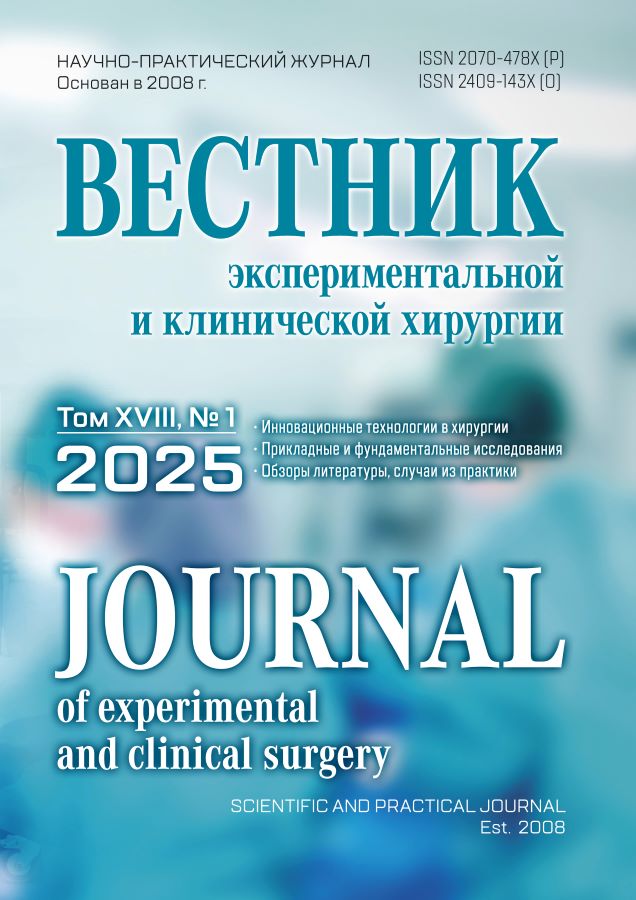Еvaluation of the effectiveness of surgical treatment in patients with extensive burns based on the studied immune status
- Authors: Kozlova M.N.1, Alekseev A.A.1,2, Zemskov V.M.1, Bobrovnikov A.E.1,2, Shishkina N.S.1, Kulikova A.N.1, Demidova V.S.1, Solovieva M.S.1
-
Affiliations:
- A.V. Vishnevsky National Medical Research Center of Surgery
- Russian Medical Academy of Continuous Professional Education
- Issue: Vol 18, No 1 (2025)
- Pages: 9-18
- Section: Original articles
- URL: https://vestnik-surgery.com/journal/article/view/1828
- DOI: https://doi.org/10.18499/2070-478X-2025-18-1-9-18
- ID: 1828
Cite item
Abstract
Background. The concept of comprehensive treatment of burns is based on active surgical tactics aimed at removing necrotic tissues and restoring the integrity of the skin at earlier terms, which is essential for the prevention of purulent-septic complications of burn disease. Timely diagnosis of the development of infectious septic complications and immunodeficiency conditions based on the immune status monitoring is an urgent task of comprehensive, including surgical, treatment of patients with extensive burns.
Aim. To evaluate the effectiveness of surgical treatment in patients with extensive burns based on a comprehensive analysis of the immunological study results.
Materials and methods. The single-center retrospective non-randomized study included 100 patients with an average burn area 47.7±1.5% of the body surface (b.s.). Of these, deep burns averaged 16.5±1.7% b.s. All patients underwent comprehensive treatment based on clinical recommendations in the field of surgery (combustiology), including surgical necrectomy, local drug treatment of burn wounds using modern wound coverings and skin grafting to close wounds. The immune status was monitored in 100 patients using flow cytometry, turbidimetry and chemiluminescence techniques starting from the moment of admission to the Burn Center; in 55 of them the immune status was monitored in dynamics on the 10th and 30th days of treatment. The immune status parameters of 30 donors were used to compare the patients’ data.
Results. Reliably significant (p<0.05) alternative changes were identified in 15 key immune markers: leukocytes, band neutrophils, total lymphocytes, blood leukocyte shift index, leukocyte intoxication index, CD4+/CD8+, CD21+, CD64+, HLA-DR+ monocytes, HLA- DR+ lymphocytes, CD25+, CD16+, CD56+, IgG and IgM. Complex treatment of burn disease, prevention and treatment of its complications, resulted in a consistent normalization of the immune status in 43 (78%) patients in 40.8 ± 2.9 days after the burn injury; these patients had been exposed to timely removal of non-viable tissue, their burn wounds had been prepared for plastic closure using modern wound dressings and water-soluble ointments, autodermoplasty had been performed as early as possible. Simultaneously, positive changes in key immune markers with relief of endogenous intoxication and infectious-inflammatory reaction, normalization of antimicrobial potential in general allowed effectively continuing surgical treatment to restore the skin.
Conclusions. The results obtained based on the first used multiparametric panel of immune markers do not only emphasize the importance of active surgical tactics in providing specialized medical care to victims with extensive burns, but also allow for its timely correction at various stages of complex treatment in severely burned patients.
Keywords
Full Text
About the authors
Maria N. Kozlova
A.V. Vishnevsky National Medical Research Center of Surgery
Author for correspondence.
Email: mnkozlova@rambler.ru
Ph.D., Senior Researcher at the Department of Thermal Lesions
Russian Federation, MoscowAndrey A. Alekseev
A.V. Vishnevsky National Medical Research Center of Surgery; Russian Medical Academy of Continuous Professional Education
Email: alexseev@ixv.ru
M.D., Professor, Head of the Burn Center, Deputy Director
Russian Federation, Moscow; MoscowVladimir M. Zemskov
A.V. Vishnevsky National Medical Research Center of Surgery
Email: arturrego@yandex.ru
M.D., Professor, Chief Researcher at the Clinical Diagnostic Laboratory
Russian Federation, MoscowAlexandr E. Bobrovnikov
A.V. Vishnevsky National Medical Research Center of Surgery; Russian Medical Academy of Continuous Professional Education
Email: doctorbobr@mail.ru
M.D., Associate Professor, Head of the Burn Department, Professor of the Department of Thermal Injuries, Wounds and Wound Infection
Russian Federation, Moscow; MoscowNadezhda S. Shishkina
A.V. Vishnevsky National Medical Research Center of Surgery
Email: nadya-vesy@mail.ru
Junior Researcher at the Clinical Diagnostic Laboratory
Russian Federation, MoscowAnna N. Kulikova
A.V. Vishnevsky National Medical Research Center of Surgery
Email: shinshila72@mail.ru
Valentina S. Demidova
A.V. Vishnevsky National Medical Research Center of Surgery
Email: demidova@ixv.ru
M.D., Head of the Clinical and Diagnostic Laboratory
Russian Federation, MoscowMarina S. Solovieva
A.V. Vishnevsky National Medical Research Center of Surgery
Email: solovevama@ixv.ru
Ph.D., Senior Researcher at the Clinical Diagnostic Laboratory
Russian Federation, MoscowReferences
- Alekseev AA, Salahiddinov KZ, Gavrilyuk BK, Tyurnikov YuI. Comprehensive treatment of deep burns based on the use of surgical necrectomy and modern biotechnological methods. Annaly hirurgii. 2012; 6: 41-45. (in Russ.)
- Greenhalgh DG. Management of Burns. N Engl J Med. 2019; 380(24): 2349-2359. doi: 10.1056/NEJMra1807442
- Litman GW, Rast JP, Fugmann SD. The origins of vertebrate adaptive immunity. Nature Rev Immunol. 2010; 10: 543–553. doi: 10.1038/nri2807
- Ebert G. Immunity by equilibrium. Nature Rev Immunol. 2016; 16: 524–532. doi: 10.1038/nri.2016.75
- Zemskov VM, Barsukov AA, Gnatenko DA, Shishkina NS, Kulikova AN, Kozlova MN. Fundamental and applied aspects of the analysis of oxygen metabolism of phagocytic cells. Uspekhi sovremennoj biologii. 2013; 133: 5: 469-480. (in Russ.)
- Auger C, Samadi O, Jeschke MG. Biochemical alterations underlying post-burn hypermetabolism. Biochem. Biophys. Acta Mol. Basis Dis. 2017; 1863: 2633–2644. doi: 10.1016/j.bbadis.2017.02.019
- Hotchkiss RS, Monneret G, Payen D. Sepsis-induced immunosuppression: from cellular dysfunctions to immunotherapy. Nature Rev Immunol. 2013; 13: 862–874. doi: 10.1038/nri3552
- Zemskov VM, Alekseev AA, Gnatenko DA, Kozlova MN, Shishkina NS, Zemskov AM, Zhegalova IV, Bleykhman DA, Bahov NI, Suchkov SV. Composite Biomarker Panel as a Highly Informative and Reliable Tool for Predicting Septic Complications. Jacobs Journal of Biomarkers. 2016; 2: 1: 1-10.
- Boomer JS, To K, Chang KC, Takasu O, Osborne DF, Walton AH, Bricker TL, Jarman SD, Kreisel D, Krupnick AS, Srivastava A, Swanson PE, Green JM, Hotchkiss RS. Immunosuppression in patients who die of sepsis and multiple organ failure. JAMA. 2011; 306: 2594–2605. doi: 10.1001/jama.2011.1829
- Zemskov VM, Alekseev AA, Kozlova MN, Shishkina NS, Gnatenko DA, Zemskov AM, Bahov NI. Immune diagnosis of septic complications in burns. Uspekhi sovremennoj biologii. 2015; 135: 6: 531-541. (in Russ.)
- Kozlova MN, Zemskov VM, Alekseev AA. Immunodiagnostics and immunotherapy of burn sepsis. Vestnik eksperimental'noj i klinicheskoj hirurgii. 2023; 16: 3: 261-270. (in Russ.)
- Shimizu K, Ogura H, Asahara T, Nomoto K, Matsushima A, Hayakawa K, Ikegawa H, Tasaki O, Kuwagata Y, Shimazu T. Gut microbiota and environment in patients with major burns–a preliminary report. Burns. 2015; 41: 28–33. doi: 10.1016/j.burns.2014.10.019
- Hotchkiss RS, Karl IE. The pathophysiology and treatment of sepsis. N Engl J Med. 2003; 348: 138–150. doi: 10.1056/NEJMra021333
- Johnson C. Management of burns. Surgery. 2018; 36: 435–440. https://doi.org/10.1016/j.mpsur.2018.05.004
- Jeschke MG, van Baar ME, Choudhry MA, Chung KK, Gibran NS, Logsetty S. Burn injury. Nat Rev Dis Primers. 2020; 6(1):11. doi: 10.1038/s41572-020-0145-5
- Klinicheskie rekomendacii: «Ozhogi termicheskie i himicheskie. Ozhogi solnechnye. Ozhogi dyhatel'nyh putej». 2021. Dostupno po: https://cr.minzdrav.gov.ru/recomend/687_1. Ssylka aktivna na 20.06.2024. (in Russ.)
- Zemskov VM, Alekseev AA, Kozlova MN, Barsukov AA, Solov'eva MS, Ahmadov MA. Study of the clinical and immunological efficacy of immunoreplacement therapy with gabriglobin in the treatment of burn disease and its complications. RMZh. 2012; 5: 216-222. (in Russ.)
- Ljutov VA, Aleshkin VA, Donjush EK, Zajakina LB, Mostovskaja EV, Sokolov DV. Gabriglobin-IgG - possibilities and efficiency of clinical application. Lechenie i profilaktika. 2016; 4: 20: 74-80. (in Russ.)
- Zemskov VM, Alekseev AA, Kozlova MN, Shishkina NS, Bleykhman DA, Zemskov AM, Suchkov SV. Changes in the immune system depending on the stage of burn disease and the area of thermal destruction. Immunoglobin replacement therapy with gabriglobin. International Journal of Recent Scientific Research. 2017; 8: 2: 15653-15662.
- Kozlova MN, Zemskov VM, Shishkina NS, Barsukov AA, Demidova VS, Alekseev AA. Personalized algorithm of immunocorrection with intravenous immunoglobulins for preventing and treating complications of burn disease by comprehensively analyzing immune status. Rossijskij immunologicheskij zhurnal. 2020; 23: 4: 523-528. (in Russ.)
Supplementary files




















